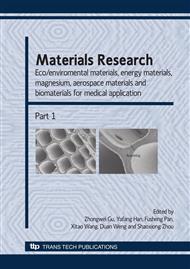p.211
p.215
p.220
p.225
p.229
p.233
p.239
p.243
p.248
Studies on the Active Oxygen in Zinc Oxides with Different Morphologies
Abstract:
Active oxygen species generated from semiconductor under irradiation play an important role in decomposing and mineralizing pollutants and undesirable compounds in the air and waste water. The production of superoxide anion (O2-) and hydroxyl radical (•OH) generated in the suspension of zinc oxides with different morphologies and particle sizes were studied in the present paper. Three kinds of zinc oxides, which named tetra-needle like ZnO (T-ZnO) whisker with length of 10~20 μm and basal diameter of 1~3 μm, nanosized ZnO (n-ZnO) with particle size of 20~30 nm and commercial ZnO powder (p-ZnO) with particle size of ~1 μm, respectively, were used in this work. Nitroblue tetrazolium (abbr. NBT) was used to determine the amount of super oxide anion generated from the related zinc oxides, in which NBT can be reduced to insoluble purple formazan by super oxide anion. The amount of hydroxyl radicals was determined by detecting the decreased absorption intensity of Fe(phen)32+ (complex of iron (II) with 1,10-phenanthroline) at 510 nm with UV-Vis spectrophotometer. The results indicated that the most amounts of superoxide anion and hydroxyl radical were detected in T-ZnO whiskers and n-ZnO respectively. The difference between the production amount of superoxide anion and hydroxyl radical can be attributed to the different mechanisms for both of the production and transportation of these two kinds of active oxygens.
Info:
Periodical:
Pages:
229-232
Citation:
Online since:
January 2009
Authors:
Keywords:
Price:
Сopyright:
© 2009 Trans Tech Publications Ltd. All Rights Reserved
Share:
Citation:


